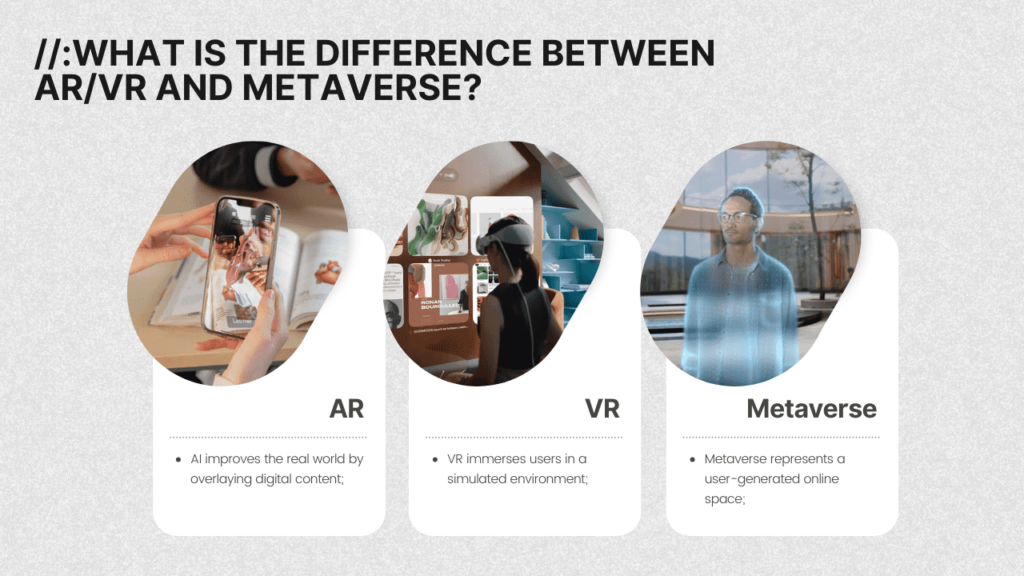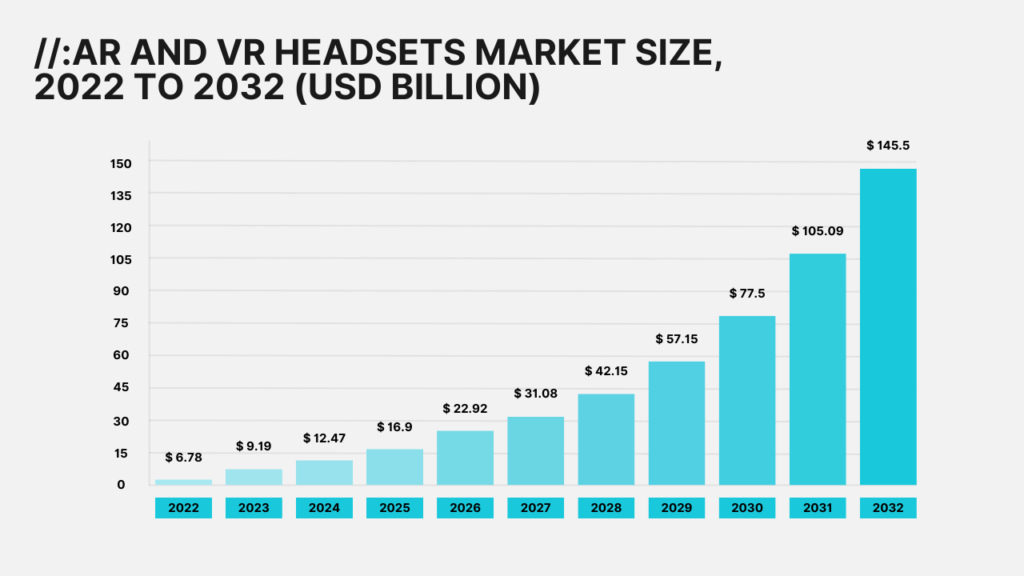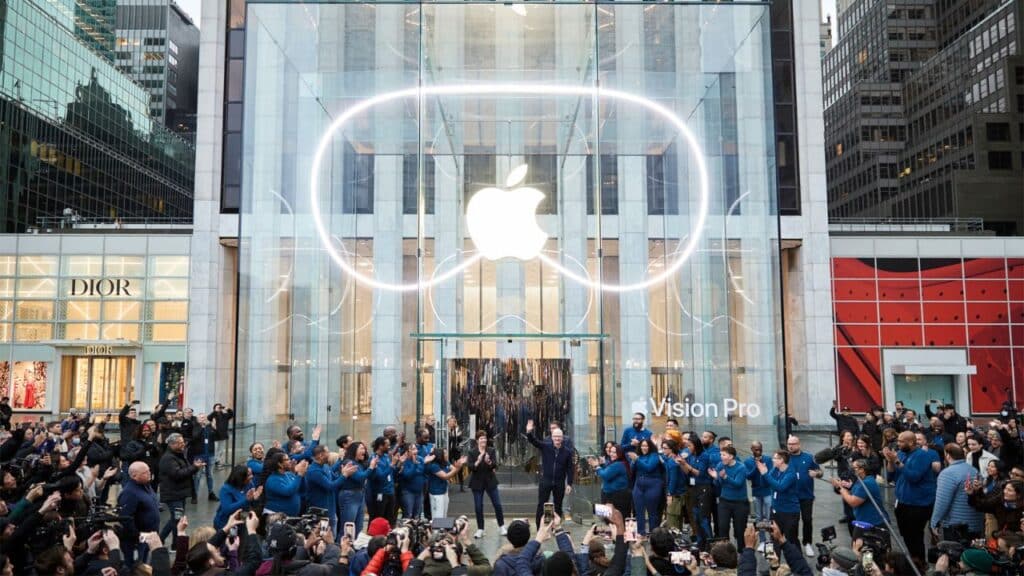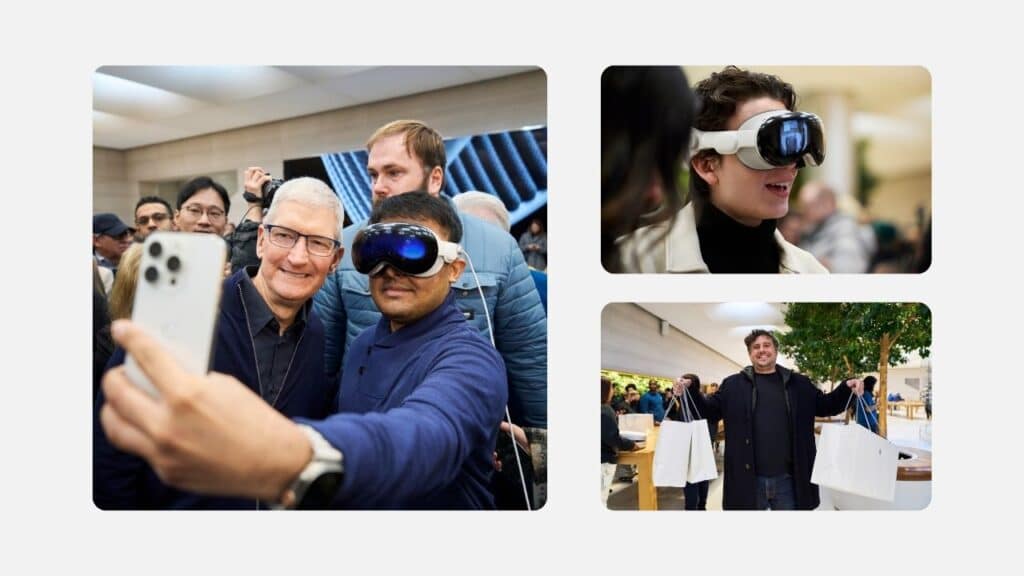The Influence of Market Demand for AR/VR Headsets on the Metaverse and Spatial Computing
Picture a world where you can shop, communicate with others, and work – all from the comfort of your home. Sounds like something from the future, right? Well, not anymore. Thanks to the latest innovations in AR and VR, this future is getting closer every day. These technologies bring a mix of the real world and the virtual world, making extraordinary things possible right from where you are. So, what is the impact of AR/VR technology on the metaverse and spatial computing? Is VR important for metaverse? How big is the VR/AR metaverse market? Buckle up and stay tuned for more revelations ahead!
What is metaverse?
Before we dive into the impact of AR/VR technology on metaverse and spatial computing, let’s first define these 2 concepts – metaverse and spatial computing. The concept of the Metaverse, often depicted in science fiction, refers to an interconnected virtual reality where users can engage in many activities, from socializing to working, within a shared digital space. As of today, the metaverse remains a futuristic idea rather than a fully realized entity.

However, tech visionaries and major companies are actively working towards bringing this concept to life – for example, Meta. Having revolutionized social connectivity with Facebook’s inception and subsequent game-changing apps like Instagram or WhatsApp, Meta is now steering beyond the confines of 2D screens. The company’s vision extends towards immersive realms, embracing augmented, virtual, and mixed reality to shape the next frontier in social technology- the metaverse. Meta’s ambitious goal is clear – to extend the metaverse’s reach to a billion people in the next decade – marking a revolutionary chapter in global digital connectivity.
What is the concept of spatial computing?
Unlike the theoretical concept of the metaverse, AR/VR technologies already exist and are actively shaping the present, providing immersive experiences and innovative solutions across various industries.
Spatial computing is revolutionizing business operations, transforming the way we perceive and engage with information, and allowing users to interact with digital content in a 3-dimensional space. This opens up numerous new possibilities for businesses and industries, for example, health, education, gaming, retail, and so much more.
Key market players in AR/VR include major companies such as Apple, Sony Corporation, Google LLC, Samsung Electronics, Oculus VR (Meta), and HTC Corporation.
What is the difference between AR/VR and metaverse?
In unraveling the distinctions between AR/VR and the metaverse, it’s essential to understand their unique roles in shaping our digital experiences. The core distinction between Augmented Reality, Virtual Reality, and the metaverse lies in their fundamental nature.

Thus, AR enriches the physical environment with digital elements. VR provides a wholly simulated experience, and the metaverse goes beyond, offering a collectively crafted online realm where users interact and create their own digital spaces.
How is AR/VR used in the metaverse?
In general, VR plays a crucial role in fully engaging with the 3D virtual environments of the metaverse. Using 3D computer modeling, VR offers immersive visual designs, making it essential for a comprehensive metaverse experience. In the Facebook metaverse, accessibility may extend to augmented reality glasses, virtual reality headsets, and, to some extent, desktop and mobile applications.
For instance, Meta Quest Pro transforms design processes with VR painting, studio apps, and 3D exploration. Authentic avatar expressions enhance virtual meetings, while a streamlined design prioritizes comfort and accommodates glasses wearers. The Infinite Display, with patented pancake lens technology, offers a slimmer design and crisp visuals, and self-tracking controllers provide intuitive VR interactions.
The increasing market demand for VR/AR headsets is poised to have a profound impact on the metaverse and spatial computing. As more users embrace these immersive technologies, the metaverse is expected to expand, offering richer and more interactive digital experiences. The demand for VR/AR headsets is likely to drive advancements in spatial computing, improving the seamless integration of virtual and physical worlds. This surge in demand signifies a transformative shift in how individuals interact with digital content, work, and socialize, paving the way for a more interconnected and immersive future.
AR/VR: market potential and forecasts

The AR and VR market has witnessed substantial growth on a global scale, with countries like China and the United States emerging as pioneers in fostering innovation and widespread adoption of these transformative technologies.
As recent projections from Statista indicate, the AR & VR market is poised to make a significant impact, with anticipated revenues reaching an impressive US$38.6 billion in 2024. This growth trajectory highlights the escalating interest and investment in augmented and virtual reality, showcasing their increasing importance across diverse industries, including gaming, healthcare, education, and enterprise applications.
Looking at the market of these technologies, you probably wonder, what is the demand for VR headsets? According to the report from Precedence Research, the global market for AR and VR headsets reached an estimated value of USD 6.78 billion in 2022, with projections indicating substantial growth.
And what is the market potential for AR/VR? Forecasts suggest that by 2032, the market is poised to skyrocket to approximately USD 142.5 billion, reflecting a remarkable Compound Annual Growth Rate (CAGR) of 35.6% from 2023 to 2032.
The latest headsets release: Apple Vision Pro is here
In case you’re not up to date (what is hard to believe) – this day has finally arrived. On February 2, 2024, Tim Cook and Deirdre O’Brien warmly welcomed customers at Apple Fifth Avenue in New York City as they introduced the Apple Vision Pro.

“I’ve known for years we would get here. I didn’t know when, but I knew that we would arrive here,” says Apple CEO Tim Cook.
This groundbreaking, one of the most anticipated products worldwide, the spatial computer, has just been introduced to Apple Store locations throughout the United States. Apple lovers can now experience this innovative product in-store through a unique guided demo experience, available exclusively in Apple Stores across the country. In addition to in-store demos, customers can book an appointment, explore, and purchase the Apple Vision Pro at their local Apple Store or online via apple.com and the Apple Store app.
User impressions: First experiences with Apple Vision Pro
Despite being recently released on Friday, February 2nd, the Apple Vision Pro has garnered substantial attention, and numerous customers have already acquired this cutting-edge device. Some of the users have already created comprehensive overviews of the Apple Vision Pro, sharing their insights and experiences with the innovative technology.
One famous YouTuber named Marques Brownlee, known for his expertise in Tech videos about electronics recently conducted a comprehensive review of the Apple Vision Pro, which he has been using for almost a week.
Among the standout features that impressed him the most are the device’s cutting-edge hardware capabilities. Equipped with an array of sensors, including depth sensors, infrared illuminators, lidar scanners, and RGB cameras, the Apple Vision Pro boasts advanced technology, further improved by the M2 and R1 chips and additional sensors for eye tracking within the headset.
According to the review, one of the key highlights of the Vision Pro is its groundbreaking approach to spatial computing and the delivery of a 3D spatial experience reminiscent of iPad OS but with a distinctively “glassy” feel. Brownlee emphasizes the unique sensation of interacting with a virtual environment that replicates real-world physics, resulting in an unparalleled sense of immersion.
The reviewer also underscores the device’s social and immersive features, particularly praising the introduction of Personas. This innovative feature allows users to create digital representations of themselves, improving the overall immersive and social experience. Brownlee recognizes the potential for heightened social interactions, especially during FaceTime calls, where spatial audio and dynamic window movements contribute to a remarkably realistic sense of presence.
In a recent YouTube review titled “The Thing No One Will Say About Apple Vision Pro,” another YouTuber named Casey Neistat, with more than 12 million subscribers, shares his early experiences with the device, emphasizing its challenges in motion tracking, notably in a subway setting.
In a 24-hour experiment, Wall Street Journal’s Joanna Stern spent a day with Apple’s highly anticipated Vision Pro headset. Joanna encountered typing challenges, especially for anything longer than a quick message. The beta persona feature, generating a 3D stand-in for video calls, received mixed reviews due to cosmetic distortions. Nevertheless, the headset showcased versatility, helping with tasks ranging from work to cooking with a recipe app and even recording spatial videos.
“I was skeptical at first. I don’t bow down before the great god of Apple, but I was really, really blown away,” says the famous director James Cameron.
Apple introduces over 600 fresh apps made for Apple Vision Pro
Meanwhile, first customers enjoy brand new experiences, Apple has announced the availability of over 600 new apps designed specifically for the Apple Vision Pro, adding to the existing 1 million compatible apps on the App Store.
“With more than 600 new spatial experiences to explore in the all-new App Store, alongside more than 1 million compatible apps across iOS and iPadOS, users can discover a wide array of apps that expand the boundaries of what’s possible. These incredible apps will change how we experience entertainment, music, and games, spark our imaginations with new ways to learn and explore, unlock productivity like never before, and so much more. Developers are already capturing the promise of spatial computing, and we can’t wait to see what they create next,” says Susan Prescott, Apple’s VP of Worldwide Developer Relations.

Notable apps include those for sports enthusiasts, entertainment fans, productivity tools, and engaging games. Let’s take a closer look at what Apple brings to the table:
- Entertainment: Disney+, IMAX, Max by Warner Bros. Discovery, Apple TV+ and Apple Music bring new ways to experience movies, shows, and music. The Max app offers an immersive Iron Throne Room environment for House of the Dragon fans.
- Productivity: Vision Pro serves as a powerful tool for everyday tasks, featuring an infinite canvas for multitasking and collaboration. Compatible apps include Box, MindNode, OmniFocus, Microsoft 365, Webex, Zoom, and more.
- Gaming: Apple Vision Pro has access to over 250 games on Apple Arcade and compatibility with other titles from the App Store and Mac App Store.
- Educational and Learning Opportunities: Apps like solAR, Sky Guide, Night Sky, Exploring Mars, and others create immersive, three-dimensional learning environments for users.
- Music: Unique music apps like djay, NowPlaying, STAGE+, AmazeVR Concerts, and tappr.tv offer engaging and interactive music experiences for Vision Pro users.
- Shopping: J.Crew Virtual Closet, Mytheresa: Luxury Experience, Decathlon, Lowe’s Style Studio, Wayfair Decorify, and Zillow Immerse redefine shopping experiences with augmented reality.
- Wellness and Reflection: Mindfulness apps like Healium, Lungy, Odio, and Endel provide users with tools for relaxation, meditation, and personal reflection.
Moreover, the App Store promises continuous updates with new spatial experiences, ensuring Apple Vision Pro users are always at the forefront of innovative technology.
At Kitrum, we’ve also been one of the first customers to acquire the Apple Vision Pro, and we’re gearing up to craft a comprehensive overview in the near future. Stay tuned for updates from Kitrum as we will delve into the features and functionalities of Apple Vision Pro, providing valuable insights into the capabilities it brings to the forefront of spatial computing.






